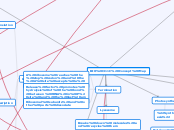realizată de Long H Nguyen 7 ani în urmă
331
BIO 311C Concept Map

realizată de Long H Nguyen 7 ani în urmă
331

Mai multe ca acesta
Pinocytosis
Phagocytosis
Receptor mediated
Introns are cut out and exons are spliced together
5' cap and Poly A tail are added to the two ends of pre-mRNA molecule in otder to facilitate the export of mature RNA from the nucleus, protect the mRNA from degrading, and help ribosomes attach to the 5' end of the mRNA when it is in the cytoplasm
RNA transcript is realsed and polymerase detaches from the DNA
Polymerase moves downstream, unwinding the DNA and elongating the RNA transcription in 5' to 3' direction
RNA Pol binds to promoter, DNA strands unwind, Pol initiates RNA synthesis at start point
Transcription in Eukaryotes
Other transcription factors bind the DNA along with RNA Pol II, forming transcription initiation complex
Transcription factors bind to DNA before RNA Pol II binds to it
TATA box nucleotide sequence (promoter)
Elongation Cycle
Translocation
Ribosome transolcates tRNA from A site to P site. Empty tRNA in P site moved to E site to get released.
Peptide bond formation
Codon Recognition
Anticodon of aminoacyl tRNA base pairs with complementary mRNA codon in A site. Binds and proceeds
Large ribosomal unit completes initiation complex. Initiation factors in charge of connection of all translation components.
Small ribosomal unit binds to mRNA. Initiator tRNA binds with start codon
Membrane bound receptor undergoes conformational change, allows for passage of ions
Allows transfer of phosphate from ATP to tyrosine kinase regions of dimer
Cell surgace transmembrane receptor that works with help of G protein
Receptor on/in plasma membrane
Receptor in cell nucleus
Receptor in cell cytoplasm
Synaptic
Neurotransmitters released and diffuses across synapse, stimulating target cell
Paracrine
Direct signaling
Distal control elements are enhancers that are located upstream/downstream of a gene
Activators bind to enhancer and bends sequence
Proximal control elements are close to promoter
Transcription factors bind to proximal elements and transcription is low
Allows RNA Pol II to bind
Repressor binds to enhancer and prevents RNA Pol II to bind
Lac I is lac repressor
Lac A adds acidicyl group to lactoes
Lac Y takes in lactose
Lac Z forms mRNA
Nucleosomes formed when DNA wraps around histone twice
Interactions between nucleosomes cause thin fiber to coil or fold into thicker fiber
Tight helical fiber needs help of H1
Nucleosomes strung together
H1 is not a part of the core
H1, H2A, H2B, H3, H4
Primer starts making leading strand and uses the existing strand as a template strand. DNA Pol III puts on new bases and lagging strand is synthesized in okazaki fragments. DNA ligase attaches these fragments together
Begins at ORI, helicase unwinds DNA. Topoisomerase releases tension. RNA primers are created
Cytosine
Guanine
Thymine
Adenine
Messeleson and Stahl
Strands separated and template synthesizes new complementary strand
Cells signals one another to tell other cells to begin replication, starting at the phospholipid bilayer
Signal molecules are attached to the phospholipid bilayer and cellular processes begin with the attachment to a receptor molecule
Point in DNA where replication begins
Where the DNA begins to separate
Synthesizes in direction away from fork
Synthesizes in direction towards replication fork
Relieves strain on DNA strands
Connects DNA
Removes RNA primers and replaces with DNA
Synthesizes new DNA strands
Creates RNA primer and attaches on at 5' end of leading strand and multiple on lagging strand
Unwinds double helix at replication forks
Can be free or bound
Proteins
Food vacuole
Central vacuole
Glycerol
Fatty acids
Lipids
Present in plants
Triglycerides
Unsaturated
Oils, kinks
Saturated